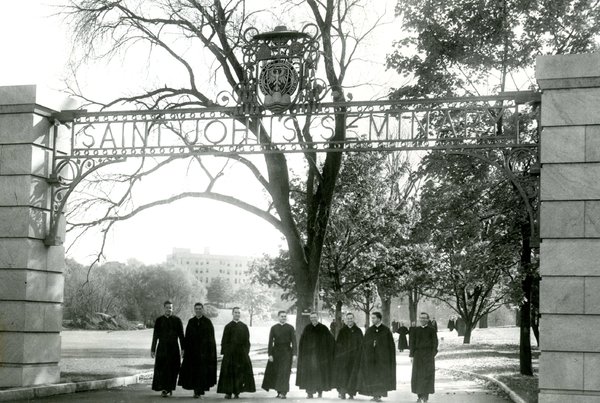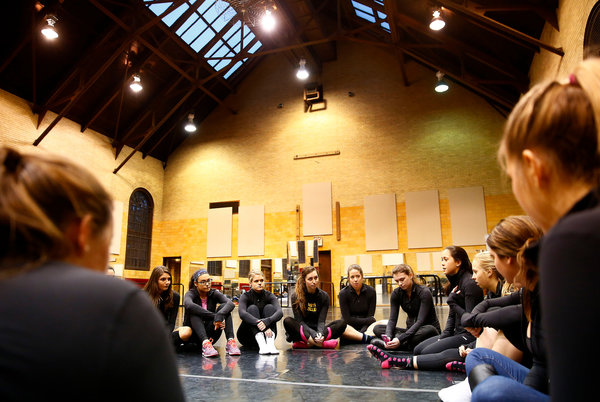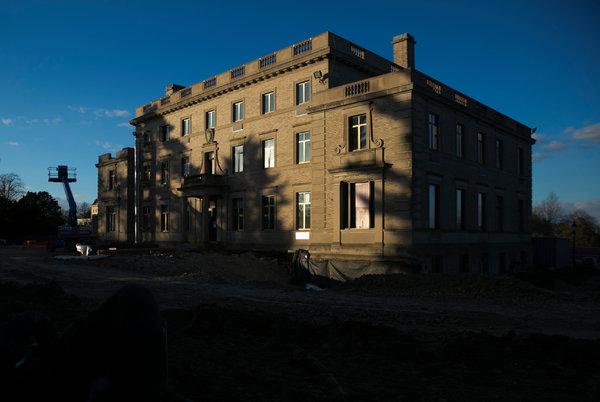Seat of Boston’s Catholic Power Gives Way to Other Pursuits
By Michael Paulson
The house on the rise has long been a symbol of Catholicism in Boston. When it was built, its grandeur demonstrated the wherewithal of the city’s newly powerful Roman Catholic community. When it was sold, the transaction reflected the straits of a once-powerful archdiocese brought low by scandal. Now, the bedrooms of the Italianate palazzo where all of Boston’s 20th-century cardinals, as well as a visiting Pope John Paul II, once slept have been gutted, in preparation for it to be remade as a museum. The conversion of the cardinals’ residence is the final step in the transformation of a leafy expanse on the western edge of Boston that was once so packed with Catholic institutions — a seminary, a college, the residence and the archdiocesan headquarters — that it was referred to as Little Rome. It is still Catholic — most of the land is owned by Boston College, a Jesuit institution, and there are crosses and a statue of St. Ignatius on the campus. But the seminary gymnasium is now a dance studio; the old tribunal, where marriages were annulled, houses a center on aging; and the former chancery is the college’s alumni center.
A decade after the Archdiocese of Boston began the process of selling property at its headquarters to Boston College to pay victims of sexual abuse by clergy members, the most visible vestiges of the land’s historical uses are an archdiocesan seminary, now in half the building it once filled, and a grave site for the cardinal who acquired much of the land but whose remains were disinterred and relocated as a condition of the real estate deal. “This property was a visible symbol of the imperial archdiocese in the early 20th century, and then, during the very difficult years in 2002 and 2003, it was a site of daily protest and picketing,” said David Quigley, a historian and the provost of Boston College. “The talented young people buzzing around the campus are the most hopeful sign that there’s something distinctly Jesuit and Catholic playing out there today, but not necessarily something that earlier leaders would have recognized.” The transformation of the 65 acres, which Boston College purchased for $172 million and refurbished for another $100 million, in many ways prefigured changes in the wider church. Even before the Archdiocese of Boston sold the land, the archbishop of Boston, Sean P. O’Malley, who as a Capuchin Franciscan friar had taken a vow of poverty, announced that he was not interested in living in the mansion of his predecessors, and moved into a modest cathedral rectory. That step has since been mirrored by Pope Francis, who lives in a Vatican guesthouse rather than the apostolic palace, and by several American prelates, including the new archbishop of Chicago, Blase J. Cupich, who have chosen more humble residences than those of their predecessors. The Archdiocese of Boston sold its headquarters for the practical purpose of settling sexual abuse cases, but the move that resulted — to a modern office building in a suburban industrial park that was donated to the archdiocese — also reflected demographic changes, as American Catholic dioceses have become smaller and more suburban.
The uses of the land echo changes in the church: In particular, Boston College has set up a new School of Theology and Ministry there, which combines the training of Jesuits — newly energized by the popularity of Francis, the first Jesuit pope — with a strong emphasis on training lay people. There is a new residence for 70 Jesuit priests on the property. Still to come, the college hopes, are residences for undergraduates, as well as baseball and softball fields, parking and, possibly, more fine arts programs near the new museum. The Brighton section of Boston, where the acreage is, began its history as a Catholic stronghold in 1880, when Archbishop John J. Williams acquired land there for a new seminary, St. John’s, which opened four years later. Boston College, then in the city’s South End, moved to land across Commonwealth Avenue from the seminary property in 1913. And Archbishop William H. O’Connell, who later became the city’s first cardinal, moved the archdiocesan offices to a site between the seminary and the college there in the 1920s, building himself the grand home with money bequeathed from the fortune of B. F. Keith, a vaudeville theater magnate. “Cardinal O’Connell was always eager to make statements about Catholic success in front of the Boston Brahmins — the Yankees — statements about Catholics having arrived after a long period of being the immigrants, the poor, the looked-down-on,” said James M. O’Toole, a Boston College history professor. “His big phrase, when he became archbishop, was ‘the Puritan has passed; the Catholic remains,’ and he was making a visible statement by building a big house in more leafy surroundings.” Cardinal O’Connell also built himself a stone mausoleum, and said in his will that he desired to be interred there after he died in 1944. But Boston College — his alma mater — did not want the responsibility of taking care of his remains. In 2011, the mausoleum was quietly dismantled and the cardinal’s body relocated to a nearby seminary courtyard. Some observers saw irony in the move: A century earlier, when Cardinal O’Connell first took over management of the seminary, he ousted the Sulpician priests who were running it at the time, and demanded they exhume and take with them the remains of their own deceased colleagues. The house had its own colorful history. When Cardinal Bernard F. Law lived there, there was a silver tray kept in the foyer, and his red biretta was placed atop the tray, or removed from it, to signal whether or not he was in the building. A group of nuns lived in the building to take care of the cardinal and the house; there was also a chapel, from which daily Mass was broadcast, and a conference room in which the table featured a plaque saying that John Paul II sat there, and the walls featured portraits of all of the diocese’s past bishops. In the basement was a swimming pool, long boarded over. During the height of Cardinal Law’s power, the house was the site of an annual garden party, to raise money for Catholic Charities, that was considered a must for the city’s power brokers, most of whom were Catholic. But as the sexual abuse crisis exploded in 2002, the house became the backdrop for protests, and in December of that year, at Creagh Library on the archdiocesan campus, Cardinal Law announced his resignation. “Originally that land was a seminary, and a seminary is to be a seedbed of priests,” said the Rev. William P. Leahy, the president of Boston College. “In some ways, it still is a seedbed, but it’s lay men and women, priests and students. It’s still a great incubator for the future of the church.”
|
.
Any original material on these pages is copyright © BishopAccountability.org 2004. Reproduce freely with attribution.


